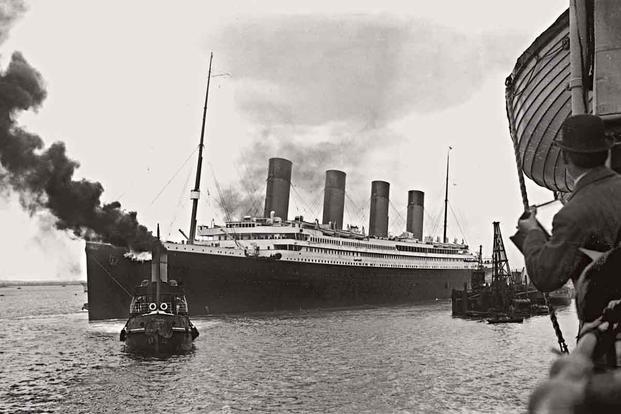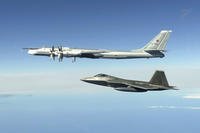The man who found the Titanic did so with help from the US Navy, and he got that much needed support in part by convincing the Navy that finding the shipwreck would "drive the Soviets crazy," renowned explorer Robert Ballard reveals in the new book "Into The Deep," which was co-written with investigative reporter Christopher Drew.
Over the course of his celebrated career, Ballard has discovered the wrecks of the Nazi battleship Bismarck, the US aircraft carrier Yorktown, and US patrol torpedo boat PT-109 (commanded by then Lt. j.g. John F. Kennedy). But his most recognizable discovery was the British passenger ship Titanic that sank in the North Atlantic on April 15, 1912, ending more than 1,500 lives.
That famous discovery in September 1985 was backed by the US Navy, which offered its support for two reasons.
The search for the Titanic was a cover for a top secret Navy mission involving the use of undersea systems to explore two submarine wrecks. And Ballard convinced the service his discovery would play into a game of psychological warfare with the Soviets during the later years of the Cold War, "Into the Deep" explains.
Navy Vice Adm. Ronald Thunman, a top submarine officer, initially told Ballard that his dream of finding the Titanic was crazy, but he ultimately agreed to let the persistent explorer piggyback on the Navy mission and pursue the lost passenger ship using any time and funds that remained after looking into the two wrecks.
"You can do whatever you want, but you gotta do it within the time and within the money, and that's it," Ballard recalled the officer saying. The search for the Titanic became cover for the submarine investigation.
Although he had been given something of a green light to look for the Titanic from Thunman, Ballard wanted the support of Navy Secretary John Lehman. He decided to leverage the secretary and President Ronald Reagan's thinking on psychological warfare to gain that endorsement as well.
Both Reagan and Lehman were eager to confront the Soviets more aggressively, and part of that included rattling them psychologically, specifically making them believe the US had capabilities beyond their own.
Ballard, then a Navy reservist, invited Lehman, who had been behind Ballard since a talk he did on underwater terrain warfare, on an underwater excursion in an exploration and research submersible looking at what Ballard described as "the undersea battlefield."
Thousands of feet beneath the surface, he repeatedly made his pitch to search for the Titanic.
"The president wants to really play with the Soviets' minds," Ballard recalled telling the Navy secretary in a paraphrased conversation presented in his memoir, "to make them think we can do far more than we're capable of."
"Let me find Titanic," the explorer said, explaining that with the gear in his possession, specifically a few robotic submersibles, he was sure he could find it in two weeks.
"I'll find it, and then we'll go public," Ballard told Lehman, "Show videos from the robots roaming through the ballrooms. It will drive the Soviets crazy. They'll think that if we're willing to publicize this capability, imagine what our Navy is doing in secret."
Lehman agreed to pass the recommendation on to Reagan, who, according to the Navy secretary, responded: "Absolutely, let's do it."
'May God bless these found souls'
The hunt for the passenger ship Titanic was the public face of a secret Navy mission to explore and take photos of the wrecks of the USS Thresher and USS Scorpion, which sank with all hands in 1963 and 1968 respectively. They were among the deadliest submarine disasters and ones the US Navy studied intensively for answers.
Ballard returned to active-duty status temporarily so that he could be read into classified material for the missions. He wrote in his book that "the Navy's investigation was my real mission." Searching for the Titanic, while a priority and long-time dream for Ballard, came second.
Sailing aboard the research vessel R/V Knorr, Ballard obscured the true mission from members of his crew.
"Given the highly classified nature of the mission, the Navy would only let me tell those with a need-to-know status what was really happening," he explained. "We told everyone we were testing equipment for the Navy."
"I wanted to do a bang-up job for the Navy, but I was also constantly thinking about how to find Titanic," Ballard wrote. As it turned out, the investigation into the submarine wrecks would prove beneficial to finding the Titanic.
Both the Thresher and Scorpion had debris trails almost a mile long. While some believed Titanic sank in one piece, there had been eyewitness accounts from survivors that it broke apart, which would leave a debris trail like the submarines that imploded.
"I visualized the ship not just breaking in two but falling to the bottom, with the heaviest pieces heading straight down and lighter ones drifting with the current, just as I had seen with Scorpion and Thresher," Ballard wrote.
"It played out like a film in my head, and, all of a sudden, it was clear as a bell," he said. "I shouldn't be searching for the ship. I should be searching for the debris trail. A mile-long trail would be easier to find than 833-foot ship."
Ballard and his team arrived in the area where the Titanic was believed to have sunk toward the end of August 1985 and deployed Argo, a ship-towed video camera sled designed to operate in deep waters that had just explored the wrecks of the Thresher and Scorpion, to scan the ocean floor.
Late one night after several days of searching for the Titanic, the team came upon the debris field, discovering a large metal cylinder over 15 feet in diameter.
"There it was, one of 29 boilers that had created steam for Titanic's engines," Ballard wrote in his book. "It was a signature piece. We'd found the debris field, about 12,500 feet down. Bull's-eye!"
Using the Knorr's onboard sonar, Ballard and his team detected a 100-foot-tall object to the north of their position. They relocated to the place the object was detected and deployed Argo to scan what turned out to be the wreckage of Titanic.
"We were drifting slowly. Titanic was unveiling herself to us," Ballard said of the moment the ship's hull came into view. "No one was blinking. Our eyes were drying out, because we were not going to close them for a nanosecond. It was an 'Oh my God!' kind of moment."
As the submersible passed over the hull, "everyone exploded," he said. "We'd done it."
In written notes on the place where Titanic sank, Ballard wrote: "It is a quiet and peaceful and fitting place for the remains of this greatest of sea tragedies to rest. May it forever remain that way, and may God bless these found souls.'
Read the original article on Business Insider.











